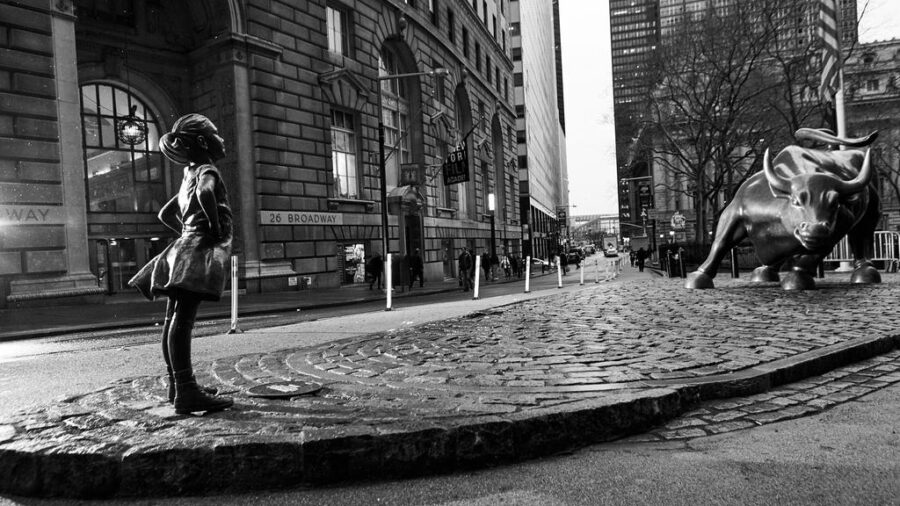The once-distinct worlds of high finance and high art are now inextricably linked, with “Wall Street,” as a metaphor for the global financial industry, exerting a profound influence on the art market. This article examines this complex relationship, highlighting how art has transcended its purely aesthetic and cultural role to become a significant financial asset class, a “collectible, store of value, and lifestyle.” This transformation is evident not only in record-breaking auction prices but also signals a fundamental shift in how art is valued, traded, and integrated into broader economic strategies. The art world has evolved into a “dynamic, global, and high-stakes industry,” attracting new collectors and astounding audiences with record-setting prices.
This financialization has immense implications. For art creators, it opens new financing avenues and market access but also pressures them to align creative work with investment considerations. Art businesses, galleries, auction houses, advisory firms, must navigate a landscape increasingly shaped by financial instruments and data-driven investors. Art is increasingly valued as a speculative financial instrument, impacting artists’ income stability and necessitating strategic financial planning. Understanding this interconnection is crucial for success in the modern art world. The financialization of art is a fundamental redefinition of its societal function, extending beyond aesthetics to include strategic financial utility. This creates a dual reality for market participants, driven by traditional art values (aesthetic, cultural) and financial metrics (ROI, asset liquidity), leading to new complexities.

History
The connection between wealth and art is ancient. In civilizations like Egypt and Greece, elites commissioned art to demonstrate power and as a “tangible investment in heritage.” During the Renaissance, families like the Medici financed masterpieces, fostering art while creating valuable assets, laying groundwork for the intertwined fate of art and economic power.
The formal conceptualization of art as an investment solidified in the early 20th century. The Peau de L’Ours (Bearskin) syndicate, founded in Paris in 1904 by financier André Level and twelve investors, pooled funds to buy works by contemporary artists like Picasso and Matisse. They liquidated the collection a decade later at a considerable profit, sharing proceeds with the artists, anticipating modern art funds and speculative interest in contemporary art. This demonstrated that art’s financialization is an intensification of a long-standing relationship.
The latter 20th century saw further developments. The British Rail Pension Fund’s 1974 decision to invest in art was a milestone, the “first very large-scale and systematic attempt to treat art as an investment vehicle.” Though its success is debated, it legitimized art as an asset class. The 1980s art market boom, fueled by Japanese buyers, financial deregulation, and US tax law changes, saw prices for Impressionist and Post-Impressionist works soar, highlighting the market’s vulnerability to speculative bubbles and economic forces. Financial institutions like UBS and Deutsche Bank built corporate collections and sponsored art fairs, modernizing patronage. These historical moments often coincided with broader economic shifts, like changes in global wealth distribution or inflation. The role of “gatekeepers” evolved from individual patrons to institutionalized, financially oriented players.
The global art market, a multi-billion dollar industry, is both resilient and sensitive to global economic shifts. The Art Basel and UBS Global Art Market Report 2025 (data for 2024) estimated worldwide art sales at USD 57.5 billion in 2024, a 12% decrease from 2023. This recalibration followed post-pandemic highs, primarily due to a slowdown at the top end (works over USD 10 million saw a 39% drop in auction volume). However, transaction volume rose by 3% to 40.5 million sales, supported by activity in lower price segments (sales under USD 5,000 increased by 7% in value and 13% in volume). This paradox suggests a broadening market base despite adjusting peak values.
Table: Key Figures of the Global Art Market 2024
| Metric | Value (2024) | Change vs. Previous Year |
|---|---|---|
| Global Art Sales (Value) | USD 57.5 billion | -12% |
| Global Transaction Volume | 40.5 million | +3% |
| Top Regional Markets (Share 2024) | USA (43%), UK (18%), China (15%) | – |
| Share of Online Sales (2024) | 18% of total sales | – |
| High-End Market (>USD 10m lots) | – | -39% in volume |
| Low-End Market (<USD 5k lots) | – | +7% in value, +13% volume |
| Private Sales (Auction Houses) | – | +14% |
| Dealer Outlook for 2025 | 33% improvement, 47% stability, 19% decline | – |
Art’s investment potential is supported by data indicating diversification benefits. The Sotheby’s Mei Moses Indices showed a long-term correlation coefficient between art and the S&P 500 of merely 0.04. From 1950 to 2020, the Mei Moses Index for the broader art market showed a compound annual growth rate (CAGR) of 8.4%, slightly outperforming the S&P 500’s 7.93%. However, figures like Warren Buffett argue against art as a primary investment due to opportunity costs. Yet, 89% of wealth managers and collectors believe art should be part of wealth management offerings, with Ultra-High-Net-Worth Individuals’ (UHNWIs) art assets estimated at over USD 2 trillion. The market is in a “bifurcated correction”: the high-price segment shrinks, while lower/middle segments show resilience, indicating a broadening collector base.
Financialization offers liquidity through art-backed loans and investment vehicles like art funds and fractional ownership but raises concerns. Critics argue it reduces art’s value to quantifiable metrics, undermining its symbolic role, pressuring artists towards marketability, and leading to opacity and manipulation. Transparency is a major concern (69% of collectors cite it as a barrier). Initiatives like the Responsible Art Market (RAM) promote ethical practices. Despite the hype, emotional and cultural values remain important, especially for younger generations prioritizing social impact and transparency.
For the next 5–10 years, the art market will continue its digital transformation. Online sales maintained an 18% share in 2024. AI is predicted to revolutionize valuation and creation; blockchain offers provenance solutions. Some forecasts see the market exceeding USD 70 billion by 2025. Economic factors like inflation and interest rates, along with geopolitical events, will influence demand and could fragment the market, focusing on regional centers like China, India, and Saudi Arabia. Societal changes include the rise of younger collectors (Millennials, Gen Z) with different preferences (emerging, digital, socially conscious art) and growing interest in female artists. Increasing market reports signal professionalization, yet subjectivity and opacity remain challenges.
Future Prospects and Trends by Art Genre
Market futures will be shaped by overarching trends and specific genre dynamics.
- Painting: Remains a cornerstone. The figuration vs. abstraction debate continues, with some reports foreseeing a comeback of large abstract works. Growing interest in artists from emerging markets like China and India is notable, with Beijing and the Indian contemporary art scene showing vibrancy.
- Sculpture & Installation: Sustainability is key, with artists using recycled materials. A growing market exists for large-scale public works and interactive/immersive installations. While the high-end unique piece market has softened, private sales remain robust.
- Photography: Digitalization is paramount, with online auctions and platforms expanding access. Social media, especially Instagram, is a crucial “showroom.” AI influences editing and valuation. However, market sensitivity exists, as shown by some photography lots underperforming at recent auctions.
- Digital Art & NFT: “Blockchain 2.0” (utility, interoperability, sustainability) shapes the future. NFTs are evolving from speculative collectibles to utility-oriented assets. The Metaverse offers new platforms. Volatility, speculative bubbles, and environmental concerns persist. Regulatory frameworks are slowly emerging. NFT trading volume has declined significantly from its peak, though Bitcoin NFTs (Ordinals) saw recent price increases.
- Performance & Live Art: Hybrid physical-digital experiences are gaining prominence. Artist residencies remain crucial. Crowdfunding is increasingly used for production.
- Urban Art: Street art is increasingly recognized as a viable “off-site” investment, with artists like Banksy and KAWS achieving high auction prices. Collaborations with major brands boost appeal. Art funds and fractional ownership are tapping into this segment.
- Ceramics, Glass & Mixed Media: Represent smaller niche markets but are growing, especially in luxury design. The global art ceramics market (USD 1.5 billion in 2025) is projected to grow. The art glass market is also expanding. Mixed media is an emerging trend.
Across genres, digitalization is transformative. A tension exists between demand for unique “masterpieces” and art’s increasing accessibility. Sustainability and social engagement are becoming important value drivers.

Actionable Recommendations: What to Do?
- For artists: Develop financial literacy and a business strategy (budgeting, diversifying income streams like prints, teaching, licenses). Strategic pricing, understanding the target audience, building a professional online presence (especially Instagram), and active networking are crucial. Carefully review gallery contracts (commission rates, exclusivity) and protect intellectual property. An entrepreneurial mindset is key.
- For galleries and art businesses: Adapt business models to market volatility. Embrace digital transformation (online sales, virtual exhibitions, social media). Cater to new collector demographics (digital art, emerging artists, transparency, social impact) and emerging markets. Diversify inventory with accessible price points. Improve transparency (pricing, provenance). Robust financial management, risk mitigation (insurance), AML compliance, fair artist relations, and balancing commercial needs with artistic integrity are vital.
- For curators and art entrepreneurs: Identify and promote emerging talent reflecting current trends. Develop innovative physical-digital exhibition and business models. Advocate for ethical practices, fair artist fees, and sustainability. Utilize market data to support decisions without neglecting artistic vision.
A critical balance between leveraging financial opportunities and upholding artistic/ethical integrity is essential for all.
What to Look Out For
Success criteria include:
- Quality and Authenticity: Fundamental to value. Rigorous verification is essential.
- Market Positioning and Brand Building: Developing a unique voice (artists) or distinct program (galleries) is crucial.
- Network Strategies: Solid relationships are critical for information and opportunities.
- Adaptability: Agility in dealing with new technologies and changing preferences is key. In a financialized market, “value” encompasses aesthetic merit, brand strength, liquidity, provenance, and alignment with trends.
Potential pitfalls include:
- Market Volatility and Illiquidity: Art can be unpredictable and difficult to sell quickly at desired prices.
- Subjectivity of Valuation: Pricing is influenced by trends and tastes.
- High Transaction Costs: Commissions, insurance, storage, framing.
- Fraud and Forgery.
- Ethical Misconduct: Conflicts of interest, lack of transparency, market manipulation undermine trust. New platforms and tools (online sales, NFTs) can introduce new risk categories.
Careful selection of partners (advisors, galleries), technologies, and financing models is vital. Ensure advisors are USPAP-compliant for valuations and transparent about fees. Assess risks of new technologies (NFTs, AI). Understand terms of art loans (typically 40-60% LTV) and art funds (fees, profit-sharing). Due diligence on partners is as important as on artworks.

What to Avoid
Common mistakes:
- Artists: Undervaluing work, neglecting marketing/sales/networking, giving up too early.
- Collectors/Investors: Buying solely on hype without due diligence (authenticity, provenance, condition), ignoring hidden costs, lack of diversification.
- Galleries: Inconsistent pricing, resisting online adaptation, deficient inventory/financial management. These often stem from misunderstanding the art market’s hybrid nature, neither purely passion-driven nor perfectly rational.
False assumptions to correct:
- Art is purely aesthetic: Ignores its significant financial dimension.
- Art is a guaranteed high-yield, liquid investment: It carries specific risks (illiquidity, volatility).
- Online presence replaces traditional models: Physical exhibitions and personal relationships remain important, especially for high-value transactions.
- Blanket dismissal of all digital art/NFTs: While risks exist, the technology offers genuine innovations.
Adherence to ethical standards is paramount for long-term credibility: avoid conflicts of interest, insider trading, market manipulation. Prioritize transparency. Maintain professionalism and a long-term vision over short-term profits. In an often-opaque market, a reputation for integrity is a significant competitive advantage.
Outlook
The intertwining of Wall Street and the art world is profound, elevating art to a significant financial asset. This financialization offers new avenues but introduces complexities regarding volatility, valuation, transparency, and ethics. Historical precedents show a long evolution, but the current era is marked by unprecedented speed and technological disruption. Understanding these dynamics is essential for all.
The future lies in navigating dualities: balancing passion with financial pragmatism, leveraging innovations while preserving authenticity, and fostering a dynamic, equitable global market. The challenge and opportunity for artists, galleries, and collectors lie in adapting, utilizing new tools, and contributing to a more transparent, responsible art ecosystem. The “New Era of the Art Market,” as Jussi Pylkkänen of Christie’s noted, requires new thinking and a commitment to cultural enrichment and sound financial stewardship. This is about informed navigation to maximize benefits and minimize risks.
Further research into the long-term societal impacts of art’s financialization and developing universally accepted best practices are crucial. Active participation in shaping the future of the art market is encouraged. Navigating this intersection requires proactive adaptation, ethical commitment, financial literacy, technical know-how, and a dedication to transparency from all participants.









